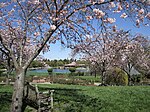Carondelet High School
1965 establishments in CaliforniaCatholic secondary schools in CaliforniaCongregation of the Sisters of Saint JosephEducational institutions established in 1965Girls' schools in California ... and 2 more
High schools in Contra Costa County, CaliforniaRoman Catholic Diocese of Oakland
Carondelet High School is an all-girls private Catholic high school in Concord, California, United States. Carondelet High School was founded in 1965 by the Sisters of Saint Joseph. The school enrolls about 800 students. It shares some resources with the all-boys De La Salle High School, which is across a side-street that separates them. De La Salle High School was founded by the Christian Brothers. Students in their junior and senior years are able to take classes at the other school for four of the school's six class periods, and also as lowerclassmen for language and art. The school is located within the Diocese of Oakland.
Excerpt from the Wikipedia article Carondelet High School (License: CC BY-SA 3.0, Authors).Carondelet High School
Normandy Court,
Geographical coordinates (GPS) Address External links Nearby Places Show on map
Geographical coordinates (GPS)
| Latitude | Longitude |
|---|---|
| N 37.933888888889 ° | E -122.03305555556 ° |
Address
Carondelet High School
Normandy Court
95498
California, United States
Open on Google Maps









